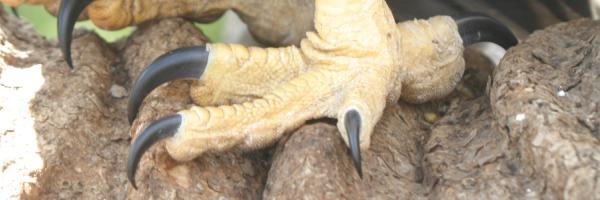Angel Muela
Versatile weapons and tools
You may have heard the expression “the clothes make the man.” In this case, the feet make the raptor. These are the powerful tools that make birds of prey such remarkable hunters. A raptor’s feet provide the best clues to what it eats, even more so than its beak. Birds of prey are found on every continent except Antarctica and range over a wide variety of habitats from desert to forest, wetland to coastline, mountain to savanna, and city to tundra. Accordingly, their diets vary considerably. Fish, insects, crabs, reptiles, amphibians, bats, birds, land and arboreal mammals, and a whole host of other wildlife big and small are on the menu for one raptor species or another.
While some raptors are able to catch many different prey animals, others are specialized feeders. This means their diet is limited to one or very few prey items. The Snail Kite is a good example of a specialized feeder. With a few exceptions, this bird of prey eats only snails. Great Horned Owls, on the other hand, hunt almost anything they can catch, including snakes, small rodents, opossums, bats, and even other raptors! Either way, each species has feet and talons perfectly designed to catch, and usually kill, its specific prey.
Talons give clues to diet
Raptors that eat large animals usually have short, strong toes. The Crowned Hawk-eagle, for example, has been known to hunt antelope up to six times its own mass! The structure of its feet allows it to battle larger prey with less risk of breaking a bone or otherwise getting hurt. Raptors that feed on snakes tend to have short, strong toes, too, but they also have thick scales on their legs to protect against snakebites.
Falcons, which are primarily bird eaters, have longer toes designed to reach through their prey’s feathers to get a good grasp on their bodies. Falcons’ feet aren’t as strong as those of some other birds of prey. They sometimes kill prey with their beaks or knock prey out of the air by hitting it with their talons clenched like a fist. Fish-eating raptors, such as Osprey and the Madagascar Fish Eagle, have rough foot pads that help them hold on to their slippery catch.
Another interesting adaptation that Osprey have is an opposable toe. Most raptors have three toes that point forward, and one pointing back, called the hallux. But Osprey, like owls, can move their smallest toe forward and backward. To get a better grip on prey or on a branch to perch, they simply move the small toe back so they have two toes facing forward and two facing back. They can return to the three forward, one back configuration any time they want.
The bird of prey with the longest legs is the Secretary Bird. This bird lives in open grasslands and savannahs of Africa. It hunts from the ground rather than the air. When it finds something to eat – such as a snake or a rodent – it stomps its prey with its feet! Some birds of prey, like the Crane Hawk, can bend their legs backward and forward at the tarsal joint. This allows them to reach inside tree cavities or crevices and root around with their feet to catch prey hiding inside.
Though it stands to reason that large raptors eat large prey and small raptors small prey, this is not always the case. The Swainson’s Hawk, a good-sized hawk, feeds on insects and rodents – relatively small prey compared to its body size. An Orange-breasted Falcon, on the other hand, has very large feet compared to its body size and catches birds almost as big as it is!
Exceptions to the rule
Compare an eagle’s feet with a vulture’s feet and you may notice that the “strong legs and sharp talons” rule doesn’t always apply. If you remember that raptor feet are best adapted for the prey they catch, it makes sense. An eagle captures and kills its prey with its feet. But since vultures eat things that are already dead, they don’t need strong feet. Their feet help them balance atop carcasses and move around comfortably on the ground when they feed. Next time you see a bird of prey, pay attention to its feet and what they tell you about the bird’s diet.







